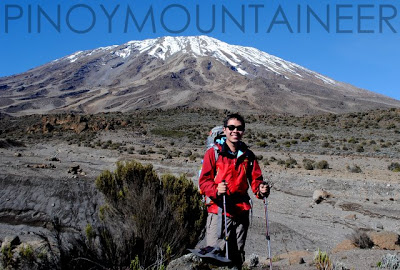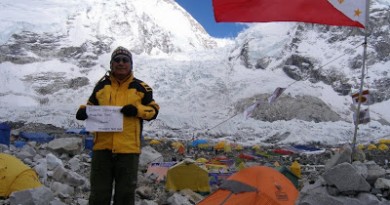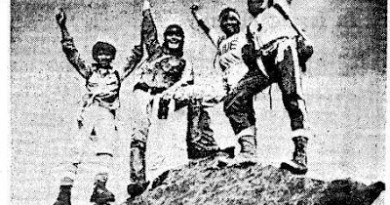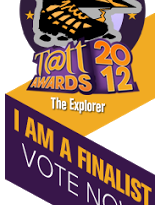MountainTalk #11: Ten questions for PinoyMountaineer
At the start of the year, some of my hiking friends sent me one question each, and my answers to them comprise the latest “MountainTalk” on PinoyMountaineer.
1. With all the hiking you do, international ones at that, you must have a lot of money!
It’s not about the money. All the money I spent on hiking last year can’t even buy a second-hand car, and you have lots of people with plenty of cars. Many of our country’s elites can afford Everest or even all the Seven Summits if they want to, but they choose to splurge on BMWs. So it’s more a question of priority than a question of money. I’m sure Romi Garduce will agree, because before he got to be sponsored, he really poured his heart and resources into hiking.
As for international climbs, hiking is actually the cheapest activity you can do abroad because you can have a good day of hiking without paying for anything! Usually, there are no guides or fees. Also, I use budget airlines and was even cited in Inquirer for doing so. I stay in backpacker inns, and I end up spending lower than what is usually assumed for international climbs. Moreover, I sometimes combine climbs with work. This month, I’m going to Europe for my studies but will try to squeeze in some winter hikes.
Finally, I combine several hikes into one trip, whenever I have a chance, so that I end up paying less for each climb. When I went to Bicol last year to do the Bicol Express, I did seven climbs and ended up paying less than 1000 for each! When we did the Visayan Voyage, I spent only 9,000 pesos for 5 Visayan mountains: Madjaas, Kanlaon, Osmena Peak, Talinis, and Pan de Azucar!
2. Congratulations on Kilimanjaro! How was the climb?
Even though it’s labelled as one of the easiest of the Seven Summits, it was actually very challenging, particularly the last two days. In terms of the trails, even the steepest parts are quite easy, but it was really the cold (-10 degrees during our summit assault) and the altitude (twice the height of Apo at the summit) that made things difficult. I made some mistakes during the climb, including bringing more than 6 kilos during summit assault, but as a result, it was a great learning experience as well.
I will narrate the details of the climb in “Hiking matters”. But right now, what I can say is that it was truly a profound experience, and I will always cherish the people in my team because we shared Kilimanjaro.
3. Did you get sponsored for Kili?
No, I didn’t get financial support for the climb, but I got supported by a lot of people, and I’m very thankful for them. Columbia Sportswear and R.O.X. Philippines, through C.O.R.E. and the very kind Tin Villaflor, gave me much-needed alpine gear and equipment from Columbia and Black Diamond, and I’m particularly grateful for the Columbia jackets and BD trekking poles, which made life easier for Kilimanjaro. I requested for a specific hiking shoe from Merrell Philippines, which they gave in time for the climb, and it also performed very well during the climb! My dad and my uncle Larry bought me some gear from the US, and my sister and brother accompanied me during a frantic search for base layers in Japan.
No, I didn’t get financial support for the climb, but I got supported by a lot of people, and I’m very thankful for them. Columbia Sportswear and R.O.X. Philippines, through C.O.R.E. and the very kind Tin Villaflor, gave me much-needed alpine gear and equipment from Columbia and Black Diamond, and I’m particularly grateful for the Columbia jackets and BD trekking poles, which made life easier for Kilimanjaro. I requested for a specific hiking shoe from Merrell Philippines, which they gave in time for the climb, and it also performed very well during the climb! My dad and my uncle Larry bought me some gear from the US, and my sister and brother accompanied me during a frantic search for base layers in Japan.
Everest climbers Romi Garduce, Regie Pablo, Leo Oracion gave me and my team much-needed advice on high altitude climbing, and my final training climb with Kibungan was with Leo, which helped a lot. Dr. Ted Esguerra, the expedition doctor of the First Philippine Mt. Everest Expedition, gave us advice on how to prevent altitude sickness and I think it worked for our team! Ivan Henares, my blogging partner, relayed my updates while in Kili on the PM Facebook page, and I thank him for his support as well!
Finally, my friends and blog readers sent a lot of encouraging messages before and during the climb. I am full of gratitude to everyone who helped make Kilimanjaro a safe, successful and special climb!
4. You did 60 climbs in 2011. Do you plan to beat that record in 2012?
I wish I could, but I doubt if I can. 2011 was the perfect combination of free time and right opportunities, but as I move in my medical career, I don’t think 2012 will be that friendly to my hiking.
Still, I have some “conservative goals” that I want to meet this year, including return trips to my favorite foreign countries, Japan and Taiwan, as well as at least five major climbs in the Philippines. If Halcon will open, I’d like to climb it, but even if it does not, I have a lot of options in my “wish list” (many of them are in Mindanao). Given my limited time this year, I’ll go for quality, not quantity, even as I end up doing dayhikes in some of my favorite spots like Batulao and Makiling!
5. Any plan to climb another one of the Seven Summits this year?
I can’t say yet. Let’s see how this year goes. An Elbrus climb will be nice, if there’s an opportunity, but it’s really tough to squeeze in a two-week trip in the middle of work and school. Yes, my next target is Elbrus. But I’m not in a hurry to pursue a lifetime goal.
6. What do you think of the Freedom Climb and other so-called “mass climbing” events?
One of my reasons for climbing is to find peace, not a crowd, on the trails (I also avoid camping in Maculot or Batulao for the same reasons) so I am averse to big climbs in general. But of course, if people want to do it, let them be, as long as they do not harm the mountains by unduly overcrowding it, or worse, by leaving garbage (The only garbage that a person who leaves garbage in the mountains takes home is himself). I’m sure that many people who join or even organize such events have good intentions, but considering the controversy that surrounds some of them, and, as Fredd Ochavo of UPM puts it, the advantage of “erring on the side of the environment”, I will continue my policy of not endorsing such events in the future (and probably, it would be better for me not to post any such event in the website, because it is sometimes interpreted as a sign of support).
I do not want to dwell on the negative, and instead of looking at things we are “against”, let us highlight instead what are for. PinoyMountaineer stands for responsible hiking and minimal-impact outdoor recreation. As an individual, I do not have the organizational resources to “save the world” by conducting clean-up climbs or tree-planting activities, but through my blog, I can support those who do so. Moreover, just by promoting responsible hiking, and promoting more destinations in order to spread (and thus reduce) impact, I think we can already contribute towards protecting the mountains. Like I said before, “If all climbs are clean climbs, there’ll be no need for clean up climbs.”
7. If you can change something in the way people climb in the Philippines, what will it be?
I will go for a change in perspective. I would like more people to pursue hiking as both an end in itself and as a means to creating a stronger relationship between ourselves and the natural environment, with a heightened sense of environmental awareness as the goal. This kind of perspective, once rooted in the consciousness of everyone, will uproot both unhealthy attitudes and unhealthy behaviors.
Unhealthy attitudes include climbing as a form of competition, which, although healthy at a certain level, when taken to the extreme, can lead to petty fights among climbers. Unhealthy behaviors, of course, including treating the mountains as an extension of the city, and thus bringing loud noises and excessive merry-making at the campsites. A healthy respect for the mountains will lead people to think twice before leaving trash in the trails. A health respect for other mountaineers will lead people to behave accordingly in the campsites, and to seek to preserve the mountain the way they saw it: as pristine as possible.
I believe that most people do not willingly violate the LNT principles; they simply don’t know what it means, and thus education is a must, and it must be done in a non-antagonistic, non-self-righteous way. Thus, hikers, instead of berating others, must take the lead to educating others in a gentle but comprehensive way. In this sense, I still highly recommend beginners to take a Basic Mountaineering Course, unless they are being mentored by an experienced hiker.
8. Can you tell us about your hiking companions? Have you selected “Team 2012” already?
My hiking companions are usually people who share my passion for hiking, and also share my preferences (i.e. small groups, post-climb food trips). For instance, Iron Lady Jo Steven and I, aside from our mutual craziness for the mountains, also enjoy Japanese food, green tea latte, and other small things. I highly value people for their loyalty, passion, unique personality, and of course, team spirit.
Somehow, I’ve managed to coalesce with these people, in serendipitous ways. Team 2012 is just an informal label and will include more people who share my passion for hiking (I have already contacted some who applied). I would like to focus on the younger generation because we need to get the youth to go hiking, in order for the sport to flourish even more in the Philippines.
If, by reading my blog, you are convinced that you and I will get along well in the trails, then you are most welcome to seek me out by emailing me!
9. How do you prepare for your climbs?
Hiking is the best preparation for more hiking, but I am sometimes in the academic oval of UP Diliman to do training runs, and I’d like to do more swimming this year. If I get too busy, I’ll probably do more runs too, in two UP campuses (Diliman and my home, UPLB). Blogging is a way of mentally preparing for climbs, too, because it makes me more excited to hit the trails, since I know that I am able to connect to people through my blog and social networks, and share my experiences to others.
10. Are you planning to climb Mt. Everest in the future?
With all humility, yes, I’d love to, given the chance.






Leave a Reply
4 Comments on "MountainTalk #11: Ten questions for PinoyMountaineer"
I was not a strong believer in BMC 2 years ago. But at the current state we the climbers are in, I think it's high time that the long forgotten BMC should enter the mountaineering scene again
Social Consciousness
Great thoughts and reading! I agree that mass-climbing-events is bad for many reasons. I myself prefer solo or max 3 people on my climbs/hike. Of my approx 500 summit climbs around the world, I've done 80% entirely alone. Can't think of anything more peaceful for my soul than that !!!!
I wish you all the best for 2012!
hi sir gid, thank you for speaking out your thoughts about mass climbing! and more power to you and your blog this 2012!
It is really nice to read number 6 and 7 (the first one) from you. Yes, we do not have resources to save the world. And "clean up climbs" is just a matter of addressing the problem, not getting solution for the root cause. Educating our fellow climbers is one of the most probable solution. This year I plan to practice LNT by heart, and share it with others.
I was not a strong believer in BMC 2 years ago. But at the current state we the climbers are in, I think it's high time that the long forgotten BMC should enter the mountaineering scene again.
And as a lowprofile veteran trailrunner/skyrunner hiking friend I recently met on a climb puts it (on adventure races), "Everybody can do it, so there's nothing to brag about. It's a matter of priority in a climb, and most important of all is maintaining a low profile".
Climbful 2012,
BPS